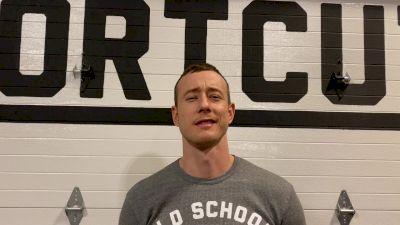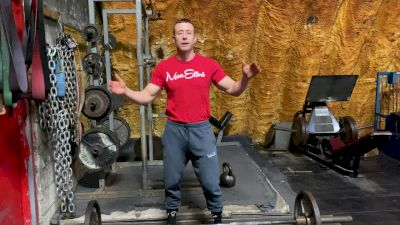Coach Myers Wrestling S&C: The King Of All Wrestling Strength Exercises
Coach Myers Wrestling S&C: The King Of All Wrestling Strength Exercises
The first installment of a new series with Coach Dustin Myers, the strength coach for the Ohio Regional Training Center.

Unlock this article, live events, and more with a subscription!
Already a subscriber? Log In
This is the first edition of a new series with Coach Dustin Myers, the strength coach for the Ohio Regional Training Center who has trained some of the world's best wrestlers. Stay tuned each week for a new strength and conditioning tip from Coach Myers aimed to help wrestlers achieve their best.
The deadlift is by far the most important strength exercise for any athlete, but especially when it comes to wrestlers. The primary muscles involved — glutes, lower back erectors, hamstrings, lats, and forearms — are all crucial to wrestling. Factor in the positioning and action of the movement (hinging over and picking something heavy up off the ground) and you can see why it doesn’t get any more “sport-specific” than the deadlift.
Now despite all of the benefits and functional application of the deadlift, it remains an exercise that is not utilized enough in the wrestling world. Perhaps that’s due to the perception of the deadlift being dangerous — and it certainly is when done incorrectly. However, if an athlete is taught perfect form from the beginning and how to lift with their muscles and not their ego, the deadlift is perfectly safe for athletes of any age.
After all, if a strong lower back and posterior chain is required to finish a high crotch in good position, wouldn’t an athlete benefit from learning how to deadlift?
The full deadlift video from Coach Myers:
Basic Technique
There are three main deadlift variations: 1) Conventional (feet narrow), 2) Sumo (feet wide), and 3) Snatch Grip (feet narrow with a super wide grip). All three are beneficial, but due to the added glute dominance and less strain on the lower back, the Sumo deadlift is the one I recommend for wrestlers.
Sumo Deadlift
Get tight to the bar with a wide stance and squat down and grab the bar (arms inside of legs) with an over/under grip. Keep your back flat and abs engaged as you pull the weight off the ground, pushing your hips to the bar as you stand up. Lower the weight under control to the starting position, or on max-effort single reps, drop the weight after locking out at the top.
Movement Keys
Hinge - even though the wide stance makes the beginning position feel like a squat, it is still technically a hip hinge. This is especially true on the way down — your hips should go back first before dropping.
Neutral spine - your lower back should be slightly arched/flat throughout the lift. If you feel yourself start to lose position with your hips, immediately let go of the bar.
Avoid Overextension - at the top during lock out, push your hips to the bar by flexing your glutes but do not lean back excessively or shrug the bar.
Tight takeoff - Once you lock into starting position, pull the slack out of the bar (see video). Once this happens, your arms should be locked and vertical and your posterior chain activated. Do NOT jerk the bar or move around once you are locked in. Simply drive your feet into the ground as you pull, hinge back, and then push your hips to the bar.
How should I program the deadlift?
For youth athletes using a KB or Trap Bar, I always keep the reps around 8-12, and definitely no lower than 5. For high school and college athletes using a barbell, we typically do sets of 5 immediately postseason, keep the reps in the 3-5 range early offseason, but then go really heavy with rest in the 1-3 range all summer. Reps will then stay around 1-3 during the season with a slight decrease in weight (80-85% 1RM in-season vs 95% 1RM for singles offseason) but an emphasis on bar speed over poundage.
Modifications
My normal progression for deadlift is:
Kettlebell or Dumbbell - youth athletes and beginners
Trap Bar - youth athletes who have mastered the KB Deadlift (20 reps of perfect form with a KB = BW is a good benchmark)
Barbell - Junior high/high school athletes who have been weightlifting a minimum of one year and can use 1.5 x BW on Trap Bar DL for sets of 5
But remember: no athlete should deadlift until they can properly hinge and brace their core properly. The movement pattern should look the same on their heavy sets as it does on their warmups.
Stay tuned to Flowrestling next week as I keep bringing you my tricks and techniques I use to train youth athletes to hinge properly, brace their core, and prepare for a lifetime of lifting heavy things off the floor!
Coach Myers is the strength coach for the Ohio Regional Training Center at The Ohio State University. With the Ohio RTC since 2012, he served as Ohio State Wrestling’s primary strength coach from 2014-18, helping the Buckeyes win three Big Ten titles, their first-ever team NCAA championship, and two runner-up finishes.
A certified strength and conditioning specialist (CSCS), Coach Myers owns the Old School Gym in Pataskala, OH, and is a founding partner of top supplement company Max Effort Muscle. Follow him on Instagram and Facebook, and learn more about his strength and conditioning programs for wrestlers of all ages here.
